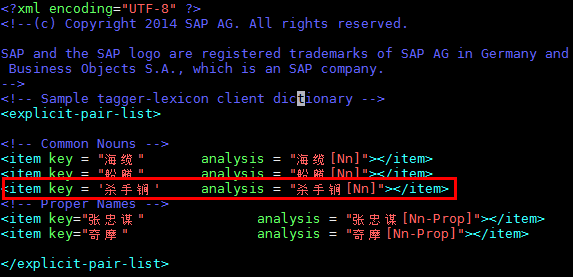
- SAP Community
- Products and Technology
- Technology
- Technology Blogs by SAP
- Custom Dictionary for Linguistic Analysis
- Subscribe to RSS Feed
- Mark as New
- Mark as Read
- Bookmark
- Subscribe
- Printer Friendly Page
- Report Inappropriate Content
There are 2 types of dictionary customization on HANA according to different TA_RULEs -- LXP and Entity Extraction.
LXP refers to LINGANALYSIS_BASIC, LINGANYALYSIS_STEMS, LINGANALYSIS_FULL, while Entity Extraction refers to others.
About how to custom dictionary for Entity Extraction, you can refer to Wenjun's blog Greetings from SAP HANA in Chinese new year - customizing text analysis extraction.
Here we work on the dictionary customization for LXP of simplified-chinese简体中文 language on HANA SP09. For example, if your table content has the word '杀手锏', and you create the LINGANALYSIS_FULL fulltext index, you will find that this word is seperated into '杀手' and '锏'. So our purpose is to make HANA identify the new word '杀手锏'.
Step 1
1.create .config file
Create a xs project and new folder "config", and create LINGANALYSIS_FULL.hdbtextconfig file in this folder

About the content of .hdbtextconfig file, please refer to chapter 3.3 Text Analysis Configuration File Syntax in guide http://help.sap.com/hana/SAP_HANA_Text_Analysis_Developer_Guide_en.pdf
The content below is somewhere you need to configure in this file:
<!-- Use custom linguistic dictionaries? (default is 'false') -->
<property name="EnableCustomDictionaries" type="boolean">
<boolean-value>true</boolean-value>
</property>
<!-- Determine whether stemming flavor is standard or expanded? (default is 'std') -->
<property name="VariantString" type="string">
<string-value>expanded</string-value>
</property>
After finish the content, activate this .hdbtextconfig file.
2.append your new words into custom dictionary
Find the custom dictionary under \usr\sap\XXX\SYS\global\hdb\custom\config\lexicon\lang\ on HANA server machine , filename is related to the value of VariantString in .hdbtextconfig file above. That is, if VariantString=expanded, filename is simplified-chinese-expanded.sample-cd; otherwise if the value is std, filename is simplified-chinese-std.sample-cd. These 2 files are the same except the filename.

Remember after finish the custom dictionary, you must reactivate the .hdbtextconfig file again to bring this dictionary into effect.
3.create fulltext index
Here the path of my .hdbtextconfig is ta_dict.config in the repository. So in the SQL of create fulltext index, configuration is 'ta_dict.config::LINGANALYSIS_FULL'.
CREATE COLUMN TABLE "SEGMENTATION_TEST" (
"URL" VARCHAR(200),
"CONTENT" NCLOB,
"LANGU" VARCHAR(10),
PRIMARY KEY ("URL")
);
CREATE FULLTEXT INDEX ta.FT_INDEX
ON ta.SEGMENTATION_TEST(CONTENT) TEXT ANALYSIS
ON CONFIGURATION 'ta_dict.config::LINGANALYSIS_FULL'
LANGUAGE COLUMN "LANGU";
INSERT INTO ta."SEGMENTATION_TEST"(URL,CONTENT,LANGU)
VALUES('XXX.XXX.XXX','杀手锏','zh');
And then you check the content of the index table, you can find '杀手锏' is there.

Besides, only japanese, simplified-chinese, traditionaly-chinese and thai languages have the corresponding sample-cd file, so I guess other languages don't support this kind of dictionary customization. I try to do with english, and it doesn't work. But I doesn't work on other languages.
Any suggestion, please leave a message.
- SAP Managed Tags:
- SAP HANA
You must be a registered user to add a comment. If you've already registered, sign in. Otherwise, register and sign in.
-
ABAP CDS Views - CDC (Change Data Capture)
2 -
AI
1 -
Analyze Workload Data
1 -
BTP
1 -
Business and IT Integration
2 -
Business application stu
1 -
Business Technology Platform
1 -
Business Trends
1,661 -
Business Trends
87 -
CAP
1 -
cf
1 -
Cloud Foundry
1 -
Confluent
1 -
Customer COE Basics and Fundamentals
1 -
Customer COE Latest and Greatest
3 -
Customer Data Browser app
1 -
Data Analysis Tool
1 -
data migration
1 -
data transfer
1 -
Datasphere
2 -
Event Information
1,400 -
Event Information
64 -
Expert
1 -
Expert Insights
178 -
Expert Insights
275 -
General
1 -
Google cloud
1 -
Google Next'24
1 -
Kafka
1 -
Life at SAP
784 -
Life at SAP
11 -
Migrate your Data App
1 -
MTA
1 -
Network Performance Analysis
1 -
NodeJS
1 -
PDF
1 -
POC
1 -
Product Updates
4,577 -
Product Updates
329 -
Replication Flow
1 -
RisewithSAP
1 -
SAP BTP
1 -
SAP BTP Cloud Foundry
1 -
SAP Cloud ALM
1 -
SAP Cloud Application Programming Model
1 -
SAP Datasphere
2 -
SAP S4HANA Cloud
1 -
SAP S4HANA Migration Cockpit
1 -
Technology Updates
6,886 -
Technology Updates
407 -
Workload Fluctuations
1
- Advanced Technologies in TBML Detection in Technology Q&A
- DDIC_TYPE_INCONSISTENCY occured WPMARA in Technology Q&A
- OUT NOW: SAP Signavio February 2024 release in Technology Blogs by SAP
- TREX Revision Upgrade on Linux through shell script and Troubleshooting in Technology Blogs by Members
- Unveiling SAP BusinessObjects BI 4.3 SP04 ! in Technology Blogs by SAP
| User | Count |
|---|---|
| 13 | |
| 10 | |
| 10 | |
| 7 | |
| 7 | |
| 6 | |
| 5 | |
| 5 | |
| 5 | |
| 4 |